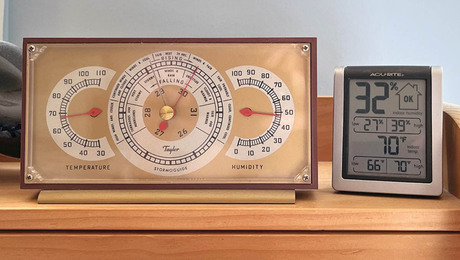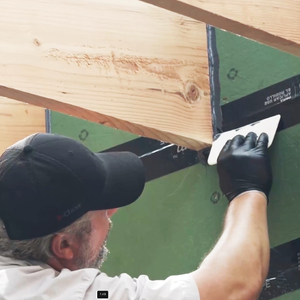I had a bridge across troubled waters…it was fallen and is starting to wash away. So, first ui will remove it. It is about 30 feet across, the foundation is loose rock that has stood the test of time, unlike the pine, yes untreated pine bridge.
Now thoughts on replacement- I beams- meatal- very heavy, engineered lumber…Tr- this project is a bit daunting, help….


















Replies
http://forums.taunton.com/tp-breaktime/messages?msg=54224.1
Try this link to a good discussion on culverts, bridges, etc.
Greg
Thanks, I think culverts are out- the wildlife comission and trouts unlimited would most likely stop this, not to mention the ice problems in the spring thaw and the look. I was planning on spanning the distance as it was done before. So, I am lookung for material to use, ex metal and PT wood don't work well together, I need a barrier, or a diffent combination, Engineered wood might be the answer. I need the bridge to be at least 5 feet wide and to carry a thousan pounds.
Thanks in advance.
" I was planning on spanning the distance as it was done before. "Well how was it done before? Just do the same thing. What the problem."I need the bridge to be at least 5 feet wide and to carry a thousan pounds."That is much different than one needed to access a home with construction equipment.DETAILS of the problem are needed. "So, I am lookung for material to use, ex metal and PT wood don't work well together,":What about CCA?What aobut a suspension bridge?What about all wood?What aobut all metal?
Edited 11/16/2006 9:54 am by BillHartmann
Like the old saying goes. " before ya build a dog house, measure the dog"
I'd research how heavy a fire truck is, then design the bridge around that.
Spheramid Enterprises Architectural Woodworks
Shooting rubber bands at the Moon
Thanks for the thgoughts- it is a private bridge, just need to carry me and my lawn tractor across with a beer
Well, just make sure you factor in the beer in your design calcs. If it's a reg'lar can, that's one thing, but a forty might drop you in the drink if you didn't plan for it.....
it is a private bridge
So, to who or whom does the watershed belong? That will be the "trick" of it. If there is a River Authority, they will set the rules you have to abide by. Especially as they get to veto any unilateral action you take.
What sorts of spans are we looking at here? Steel could get right heavy right quickly--or become a complicated ercetion issue (garden tractor is not going to be much help for a bridge needing 20' long steel beams at 15/20# the foot).
What might be simplest, maybe, would be to fell some trees of the right length, and span them, bank-to-bank, as wide as the tractor "wants." A person could spike in some stout planks perpendicular to the trunks' "run" and call the whole assembly a temporary or non-fixed structure. Using all natural 'bits' especially local to the site ought to ease any enviro concerns after the fact. But, that's pure specualtion on my part.Occupational hazard of my occupation not being around (sorry Bubba)
Gotcha.
Spheramid Enterprises Architectural Woodworks
Shooting rubber bands at the Moon
I'd use recycled steel, but these are interesting: http://www.captivecolumn.com/default.htmPAHS Designer/Builder- Bury it!
I have one neighbor at the cabin that simply dropped 2 40 in dia DF arcross and planked it over.
1200 ft upstream, the other neighbor dug into county regs on roads and driveways. and drew together some documents and got the county to build him a $200,000 bridge, all from county funds.
I have a culvert that was pre-existing. The is a 'save the steelhead' organization that has me on the list to get a 'complimentary' bridge (and remove the culvert) out of some goodie-2-shoes save the fish fund - probably too many strings attached to that.
Check all the possibilities for sucking a bridge out of us taxpayers or others before you DIY <G>
I would either look around for some used I-beams for sale, or get a couple pressure treated glu-lams. Probably the best bang for your buck.
Of course, if you can get some logs, 3 24" diameter doug fir logs would make a fine bridge there. It would take you longer though, especially if it's your first time.
There's always the railroad car bridge, they're pretty good, and quick- you supply the piers, and have someone come out and lay an old flatcar on top.
zak
"When we build, let us think that we build forever. Let it not be for present delight nor for present use alone." --John Ruskin
"so it goes"
While it may be offensive to certain aesthetic sensibilities, old mobile-home frames make pretty fair bridges. Common types use 10" or 12" JR I-beams spaced either 75" or 99" o.c. The outriggers can be cut & bent up to accept cable or board railing. Heck, why not put paddles on the wheels and light the thing with hydro power? Maybe this is an idea better suited to a forum without "Fine" in the title.
}}}}
Ah, I think this is actually the link I was trying to reference, on Suspension Bridges.
http://forums.taunton.com/tp-breaktime/messages?msg=72916.1
This might be more of the solution you're looking for.
Greg
some thoughts ..
I crossed this bridge a few years ago, based on the weight of a cemment or fire truck .. can't remember which .. width and weight are of concern so engineer recomened 4 steel beams ...
abutments of loose rock didn't fly, but gabians did ..
when the barn burned down they still parked the fire truck at the road ..
in our area if you build a bridge you are liable for the life of the bridge ..
I removed the bridge before selling the property a few years ago ..
ps after the barn burned the fire dept charged me $600 for renting a back hoe to put out the fire ..
Do you need railings?
I have always wanted to build a trussed (covered) bridge - not much lumber in that, and it would look good with your fine home. I'm certain a truss company could build you some trusses for a bridge...
I'm also fond of the curved walk bridge - Square steel tubes cambered for the "joists" and railings. I have a torch, but I've never tried to bend steel that way...
2 logs PT 2x and nails sounds like the most economical route - choose your species carefully.
"I'm certain a truss company could build you some trusses for a bridge..."
I've always refused to even though I've been asked many times.
When lumber gets wet and dries out, it can back the plates out of the wood. Obviously that's not a good thing with a bridge.
So I'd say any lumber company that would build trusses for a bridge is foolish. It's just not worth the liability.
You specifically mentioned a COVERED bridge - No one has ever asked me about that. If it was designed to keep the trusses out of the weather I would consider somethign like that.
Ever wonder why women can't put on mascara with their mouth closed?
back the plates out of the wood
'specially if the trusses are DIY with truss plates hammerd in by hand, huh?
That's what I like about this place, often something one had never thought about, and learning from other's knowledge. Always taught that wood bridge trusses joints are to be shear rings and bolts - pop's old railroad buddies told me about that long time ago when explaining why bridge washers were the shape they are.
"Always taught that wood bridge trusses joints are to be shear rings and bolts..."
I haven't seen split rings used for a heck of a long time. I know they made roof trusses with them, but I've never heard of using them for a bridge. But it makes sense - the bolts would keep the joint together.
You shall know the truth, and the truth shall make you free. [John 8:32]
Used power poles and 3x6 PT decking
Boss - I was wondering if you saw this thread - I was thinking a covered bridge -maybe doubled trusses each side, hangers on the bottom chord for the joists, gable roof on top - just leave a few spots for windows. Siding and shingles, knee braces.
We drive through a 10' high cut in an old abandoned railroad berm in the middle of our property - I have always thought a bridge over the top sized for a golf cart would be a cool addition. The span would be 30-40'.
My major concern would be wind hitting it broadside.
Treat every person you meet like you will know them the rest of your life - you just might!
"My major concern would be wind hitting it broadside."
That certainly would be a concern. And it's not something that could be designed into the trusses.
Still, it's an interesting idea. Probably too expensive to actually do, though.
That which does not kill me still hurts an awful lot.
RayF
I'd take advantage of this oppertunity to build a bridges of madison county type cover bridge.. a real timberframe work of art designed to last..
;-)
How about a used shipping container, with both ends opened up so it would be a covered bridge? You can get them 8' wide x 8 1/2' high by 40' long. It would sure be ugly but they're pretty cheap.